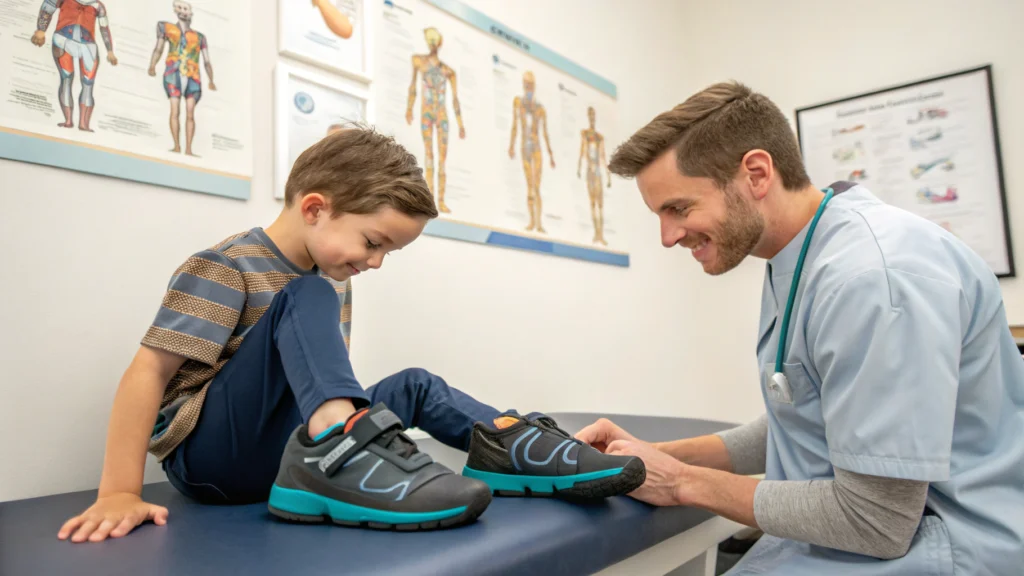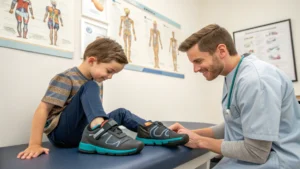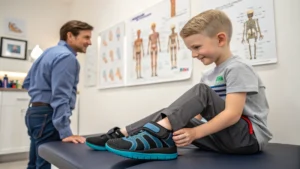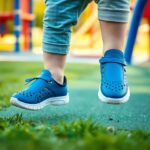
Just as you consider the developing feet of your children, understanding the orthopedic implications of barefoot footwear is crucial. This type of footwear can promote natural foot development, allowing for better muscle strength and balance. However, it can also lead to potential injuries if your child’s feet aren’t accustomed to minimal support. You need to weigh the benefits of improved proprioception and foot mechanics against the risks of injury and instability. By being informed, you can make better choices for your child’s foot health.
Unveiling the Impact of Minimalist Footwear on Pediatric Foot Development
Research indicates that minimalist footwear can significantly influence pediatric foot development by promoting natural foot mechanics. Children who frequently wear these types of shoes often demonstrate improved foot strength and flexibility compared to those in conventional options. Additionally, the exposure to varied terrains typically associated with minimalist shoes fosters important proprioception skills, critical for overall motor development during formative years.
Longitudinal Arch Formation in Children: Insights from a Three-Year Cohort Study
A recent cohort study spanning three years observed the longitudinal arch formation in children who adopted minimalist footwear. Results showed that children in this group developed more pronounced arches, highlighting their potential benefits in stimulating natural biomechanics. This aligned well with the growing emphasis on fostering optimal foot development without restrictive footwear that could hinder proper growth.
Measuring Toe Splay: Comparative Metrics Between Minimalist and Conventional Shoes
Toe splay, which is the natural splaying of toes during weight-bearing activities, was significantly greater in children wearing minimalist shoes versus those in conventional footwear. A study measuring the width of the forefoot noted an increase in toe splay by up to 15%, allowing for better grip, balance, and overall foot function. This increase in toe splay enhances the effectiveness of the foot during activities, making it an important factor in foot health.
Measuring Toe Splay: Comparative Metrics Between Minimalist and Conventional Shoes
| Type of Shoe | Average Toe Splay (mm) |
|---|---|
| Minimalist Footwear | 12-15 |
| Conventional Footwear | 8-10 |
Toe splay measurement is important in evaluating how different footwear affects foot development in children. Research revealed that minimalist shoes encourage a toe splay averaging 12-15 mm, while conventional shoes restricted splay to just 8-10 mm. This difference is significant, as increased toe splay is linked to improved stability and effective push-off during movement. By embracing footwear that promotes natural splay, you can facilitate enhanced motor skills and foot functionality in growing children.
Navigating the Landscape of Pediatric Footwear: Clinical Protocols
Adherence to clinical protocols for pediatric footwear is important for promoting healthy foot development. Regular assessments of children’s footwear can help identify any issues that may arise from improper fit or style. Establishing a checklist for evaluating shoes can streamline this process, including factors such as heel height, arch support, and toe box width. Emphasizing education for parents and caregivers on correctly selecting and maintaining footwear further enhances the likelihood of supporting strong foot health as children grow.
Age-Specific Transition Guidelines: Safely Moving from First Walkers to Adolescents
Transitioning from first walkers to adolescent footwear is a gradual process that requires consideration of your child’s foot growth and development stages. For infants, lightweight and flexible shoes that allow natural movement are ideal, while toddlers may benefit from shoes with a secure fit and added support as they begin to walk more confidently. As children grow towards adolescence, opting for footwear that balances style and necessary orthopedic support is crucial for the health of their developing feet.
Implementing School Footwear Policies: Aligning with WHO Recommendations
Establishing school footwear policies aligned with WHO recommendations can play a vital role in fostering foot health. By ensuring that students wear appropriate, supportive shoes that accommodate their physical activities, schools can promote long-term orthopedic benefits. Encouraging parents to choose footwear that provides stability and protection can reduce injury risks during recess and physical education classes. This proactive approach not only supports healthy growth but also teaches children and families the importance of choosing the right footwear.
WHO recommendations advocate for policies that promote the use of appropriate footwear to decrease foot-related health issues in children. Schools that implement these guidelines can establish mandatory standards for footwear that is both functional and conducive to healthy foot development. Engaging parents in discussions about the correct footwear choices and providing educational resources can bolster community awareness. Having a solid framework can also facilitate regular inspections of footwear to ensure adherence to standards, ultimately contributing to a healthier school environment overall.

Assessing Safety in Footwear Design: The Essential Considerations
Safety in footwear design encompasses multiple factors—padded interiors, structural integrity, and adequate performance standards. You want to select footwear that not only supports your child’s natural foot development but also minimizes risks associated with common outdoor activities. An ideal shoe should prioritize shock absorption, provide a robust grip to prevent slips, and include features that assess various environmental factors, ensuring your child’s feet are both protected and comfortable throughout different terrains.
Puncture Resistance: Testing Standards Across Leading Brands
Puncture resistance is an imperative safety feature for children’s footwear, particularly for those who explore outdoors. Leading brands often adhere to stringent testing standards, which include ASTM F891-21 for assessing how well a shoe can withstand sharp objects. These tests ensure your child’s shoes can protect their feet from potential hazards, offering peace of mind during playtime and outdoor adventures.
Evaluating Thermal Insulation: Essential Properties for Winter Models
Winter footwear must prioritize thermal insulation to keep your child’s feet warm and prevent frostbite. Materials with a high thermal resistance rating should be included in the design, enabling shoes to maintain an optimal internal temperature. Look for thermal insulation features that offer both comfort and protection, ensuring your child stays active even in the coldest conditions.
In evaluating thermal insulation for winter models, you’ll find that several features can enhance warmth. Insulating materials like Thinsulate or fleece linings are key, creating barriers against cold temperatures without compromising breathability. Look for footwear that integrates moisture-wicking properties to keep feet dry, as excess moisture can lead to heat loss. A well-designed winter shoe should also include a critique of its insulation performance, typically indicated by a thermal rating, ensuring your child can enjoy winter activities without discomfort.
Upon reflecting, you should recognize that barefoot footwear in pediatric populations presents various orthopedic implications that can significantly impact your child’s foot development and overall physical health. By encouraging natural foot movement and development, these shoes may contribute positively to biomechanics. However, it’s vital to be mindful of their proper use, ensuring your child gradually transitions to avoid discomfort or injury. Ultimately, understanding the balance between benefits and potential risks will empower you to make informed choices regarding your child’s footwear needs.
FAQ
What are the potential benefits of barefoot footwear for children?
Barefoot footwear is designed to mimic the natural shape and function of the foot, allowing for improved foot mechanics. For children, this can promote the development of strong foot muscles, enhance balance, and improve proprioception. Additionally, these shoes may encourage natural foot movement and decreased dependence on cushioned support, potentially leading to better alignment and biomechanics as they grow.
Are there any risks associated with children wearing barefoot footwear?
While barefoot footwear can offer benefits, there are some risks to consider. Children who transition too quickly to barefoot shoes may experience discomfort or increased risk of injury due to a lack of cushioning and support, especially if they are used to traditional footwear. It is important for parents to ensure that their child gradually acclimatizes to barefoot footwear, allowing time for their feet to adjust. Additionally, it is advisable to monitor for any signs of pain or foot issues during this transition phase.
How can parents determine if barefoot footwear is suitable for their child?
Parents should assess their child’s foot development, activity level, and any existing orthotic needs before choosing barefoot footwear. Consulting with a pediatrician or a podiatrist can provide valuable insights into the child’s specific foot health and requirements. Observing the child’s comfort level, foot flexibility, and any signs of discomfort when wearing these shoes can also guide the decision. Starting with short periods of wear and progressively increasing usage can help determine suitability and comfort.









Your insights on the orthopedic implications of barefoot footwear for children are astute and timely. It’s encouraging to see a growing awareness of how our choices in footwear can profoundly impact a child’s physical development. I’ve personally observed differences in my children’s mobility and confidence when they transitioned to minimalist shoes. They appear to navigate uneven surfaces with greater ease, showcasing the enhanced proprioception you mentioned.
You’ve highlighted an essential aspect of pediatric foot development that is often overlooked: the balance between the benefits and potential drawbacks of barefoot footwear. As a parent myself, I often find myself navigating the overwhelming variety of options available for my children’s shoes. It’s evident that minimalist footwear can support natural foot mechanics and enhance strength and balance, but I can’t help but wonder about the long-term implications of making such choices at a young age.
I really appreciate how you highlighted the balance between the benefits and risks of minimalist footwear for kids. It’s definitely a tricky space for parents. I remember when my child first transitioned to barefoot shoes; there was a steep learning curve in terms of adjusting to different surfaces. It really opened my eyes to how much support we often take for granted in conventional shoes.
I appreciate the insightful way you’ve brought attention to the implications of barefoot and minimalist footwear for our children’s foot development. This topic resonates deeply with me, as I’ve been on a journey exploring the balance between natural foot development and the protective benefits of traditional footwear for both my children and myself.
This discussion about barefoot footwear and its implications for children’s foot development resonates deeply with me, especially as a parent navigating the many choices surrounding children’s health and well-being. Like many families, we often find ourselves drawn to the latest options in footwear, and the idea of minimalist shoes is intriguing yet daunting—primarily because of the concerns around injury and support.
Your exploration of the benefits and risks associated with barefoot footwear for children really resonates with my own experiences as a parent. I recall when we first transitioned my child to minimalist shoes; the initial adjustment period was challenging. While I appreciated the emphasis on natural foot development and enhanced proprioception, I was also acutely aware of the potential for injury, particularly as we explored different terrains.
You raise a critical point about the balance between the benefits of minimalist footwear for children and the potential risks involved. As someone who has been exploring the impact of footwear on foot health, I appreciate how you highlight both sides of the discussion—it’s essential for parents to be fully informed.